Empower Personal Dashboard FREE

Product Name: Empower Personal Dashboard
Product Description: Empower Personal Dashboard is a free personal finance tool that can collect your financial data into one easy to read dashboard. They offer a rich set of features to help you build wealth, plan for the future, and can put you in touch with wealth advisors if that's something you're interested in (if you aren't, make sure you let them know because they are persistent).
About Empower
Empower is a financial services company that primarily offers retirement plan recordkeeping. They are based out of Colorado and the second largest retirement plan provider in the United States. Founded in 1891, they have over a trillion in assets under management.
Overall
-
Features
-
Ease of Use
-
Fees
-
Customer Service
Pros
Easy to set up
Rich investment analysis tools
Intuitive design and user interface
Cons
Budgeting tool needs improvement
No historical data (can’t import either)
Want to know how Empower Personal Dashboard (formerly Personal Capital) helped me manage all of my money, including investments, in only a few minutes a month? You’re in the right place.
When I first started managing my money, I did everything manually in a spreadsheet.
Every month, I’d log in to each of my accounts and record the balance in my Net Worth Record. I’d go into my bank accounts, my investment accounts, my mutual fund account, my credit card accounts…
It would take me an entire hour to get every account. It was so bad that I started consolidating and closing accounts just to shorten the process.
For a very brief moment, many years ago, I tried Quicken and subsequently Mint. They were all OK — but they didn’t do a good job integrating my brokerage accounts. Eventually, I abandoned them and went back to manually logging in. (if you are looking to quit Quicken, keep reading, you’ll see why I list Empower Personal Dashboard as one of the best alternatives to Quicken)
Fast forward to today and I spend just 15 minutes each month managing my money.
Just 15 minutes each month plus another five each week is enough to get everything right… and the cornerstone of that system is a tool called Empower Personal Dashboard.
It’s free, it’s well-designed and what started as a test run has become my permanent solution (it’s my favorite of the Mint alternatives).
I use Empower as a way to quickly collect brokerage investing and banking data for my Net Worth Record, a spreadsheet I use to track our family’s net worth. Empower will pull the data from each account so I don’t need to manually log in. It separates itself from other services because the investment management portion is not an afterthought and fully integrated into the system.
Many other tools started as a budgeting tool that added on an investment component. Empower started as an investment tool that added in budgeting.
Table of Contents
- About Empower Personal Dashboard
- The Sign Up Process
- Transactions
- Portfolio Tracking
- Tracking Other Non-Investment Assets
- Complimentary Portfolio Review
- Other Free Tools
- Retirement Planner
- Financial Roadmap
- Empower Personal Cash
- Additional Services
- Smart Withdrawal
- Empower Fees
- Empower vs. Mint: Is Empower better than Mint?
- Is Empower Personal Dashboard Safe?
- What Needs Work?
- Final Word
🔃Updated December 2023 to update the screenshots, which largely remained the same except for a new logo and new fonts. Nothing changed about the tools themselves.
About Empower Personal Dashboard
Personal Capital was founded in mid-2009 with the mission of “better financial lives through technology and people.” In 2020, they were acquired by Empower, which is the second largest retirement provider in the United States. In February of 2023, they were rebranded from Personal Capital to Empower Personal Dashboard.
❓What happened to Personal Capital? Personal Capital was acquired by Empower Retirement in 2020 and in February 2023, it was re-branded into Empower Personal Dashboard. Everything about the tools remained the same except for a new logo and name. You can read more about what happened to Personal Capital in this post.
As of March 2022, they serve 3.3+ million registered users (I am one of them!) and manage over $23.2 billion in assets for over 31,800 clients (that’s what pays for the service, fees on those managed investment assets) – that’s some serious cash.
The business has two components: a free personal finance aggregation tool and a paid advisory service. This review will look only at the aggregation tool side as I haven’t used the paid advisory service.
Located in California, it was founded by Rob Foregger, Bill Harris, and Louis Gasparini. Bill Harris was the CEO of Persona Capital and was formerly CEO of Intuit, Paypal, and several other financial services and security companies.
The Sign Up Process
Signing up was fast and they had every one of my accounts available for linking, including my Maryland 529 plans. Take that Quicken!
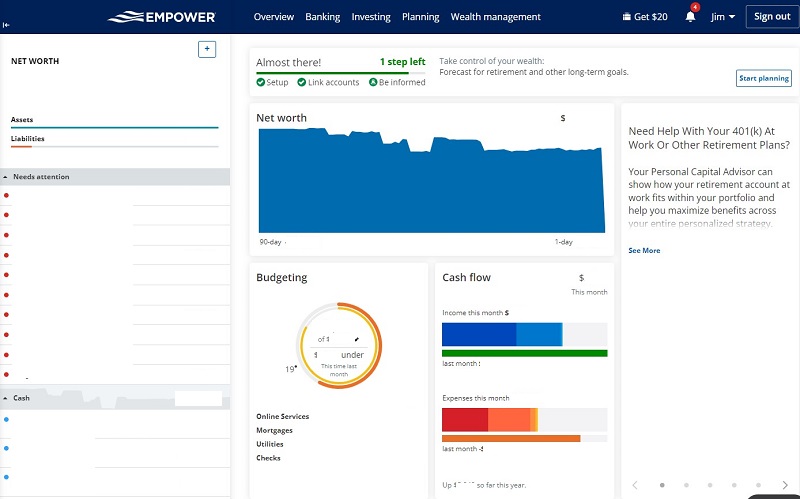
Transactions
The Transactions menu item is where you’ll find the budgeting tools that were the newest addition to Empower Personal Dashboard. If you’ve used Mint or other budgeting tools, it’ll look familiar.
You have a list of transactions categorized into Income and Spending, followed by Bills.
Here’s a shot of the All Income Cash Flow chart:
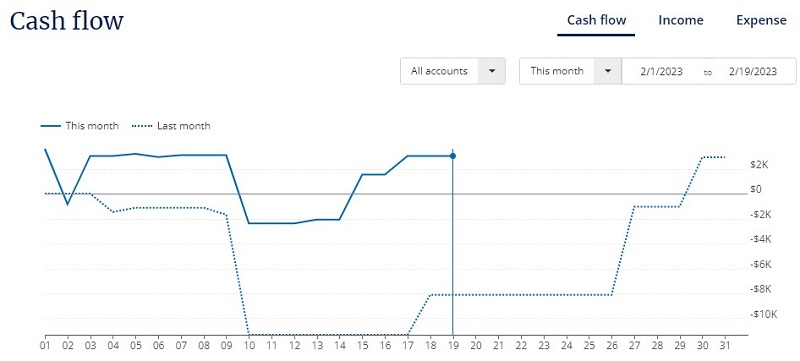
Like any tool, there are a few hiccups to adjust post-transaction, especially when you transfer between accounts, but it’s a quick adjustment.
Until you do that, you sometimes get wildly crazy numbers. 🙂
Portfolio Tracking
As I mentioned earlier, Empower Personal Dashboard started on the investment side and only recently added the budgeting toolset… so the portfolio tools are better.
Here’s what I see under Investing -> Holdings:
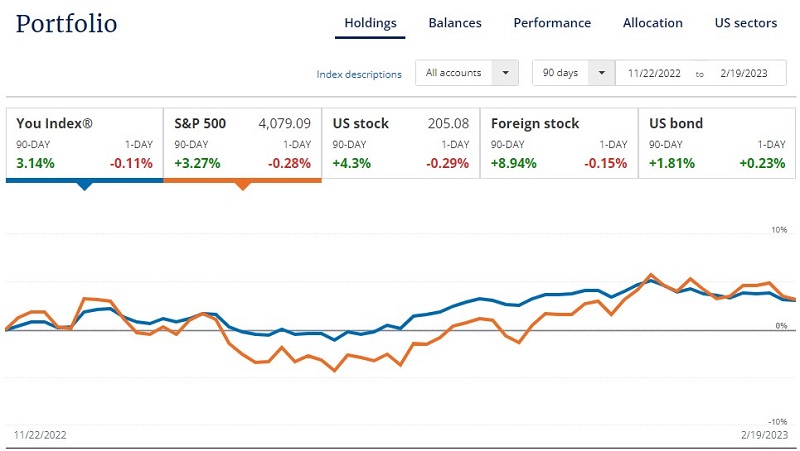
This snapshot was taken in the morning of February 19th, 2023.
As you can see, we’ve enjoyed a good run for the start of the year.
The Balances and Performance tabs are less interesting than the Allocation tab.
Empower pulls this data from all of my brokerage accounts, which right now is just at Vanguard and Ally Invest, and giving me a full breakdown of my allocation. I can click on one of the boxes and it can give me an even granular breakdown:
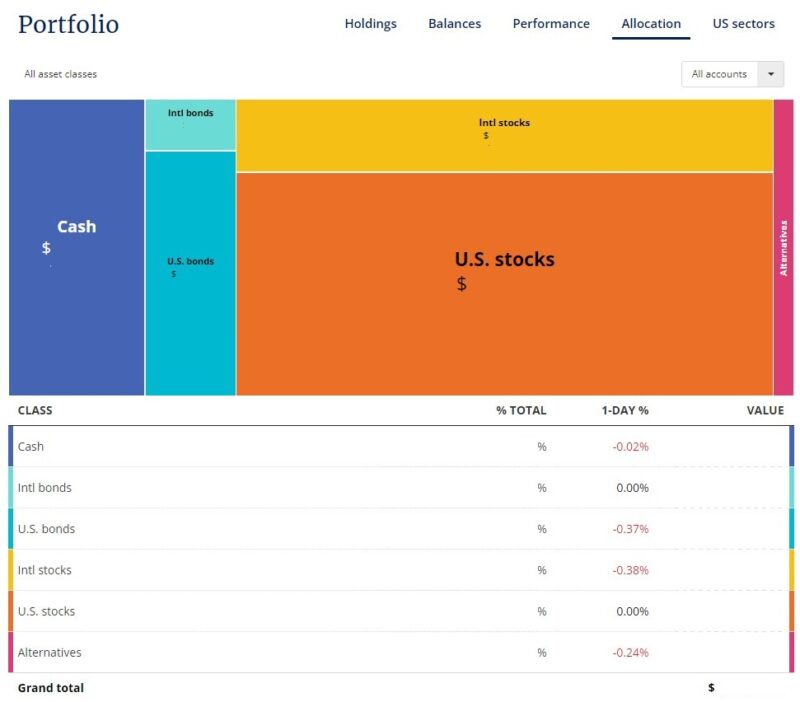
If you click down one more level, it starts telling you the actual holding and the amounts you have.
The last fun chart we have is US Sectors:
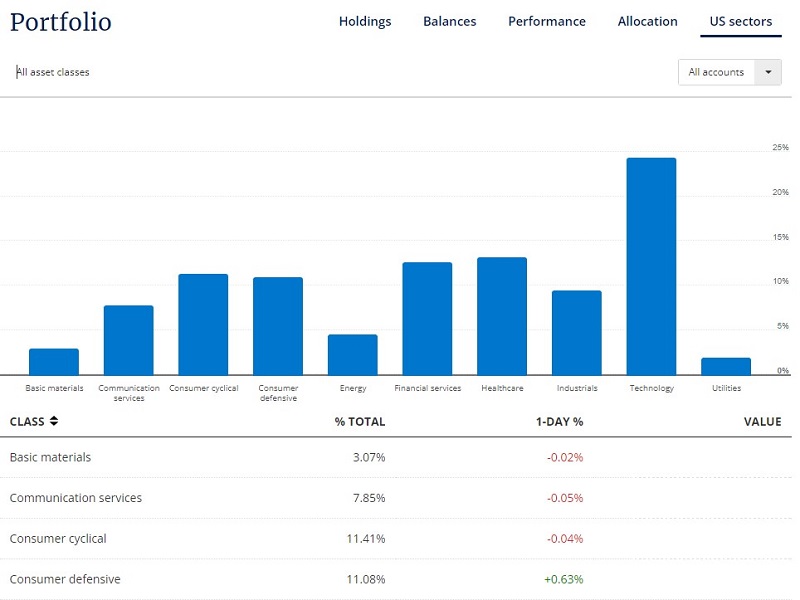
It breaks down your investments based on the sector:
- Basic materials
- Communication services
- Consumer cyclical
- Consumer defensive
- Energy
- Financial services
- Healthcare
- Industrials
- Technology
- Utilities
Can’t Find Your Institution?
If you are having trouble finding your financial institution, Empower may not have added support for them yet. For quite some time, my brokerage wasn’t supported (it is now) but there are workarounds.
First, you can check if perhaps your institution is named something else. The best example is a Fidelity 401(k) – it turns out that it’s run through NetBenefits. If you have a Fidelity 401(k) then you won’t find “Fidelity 401k” in the account listings – it says Fidelity (All accounts except 401k). For an actual Fidelity 401k, you will need the NetBenefits one.
If you work at Textron and want to find your 401k for them, it’s Fidelity NetBenefits Textron. Confusing but at least it’s there!
Next, you can manually add publicly traded securities into a portfolio that Empower will track on your behalf. So previously, I just put in all my holdings. 100 shares of Company Y, 150 shares of Company Z, etc. It’s cumbersome the first time but then it tracks as normal.
Tracking Other Non-Investment Assets
You can track “other assets” like art, cars, etc – there just isn’t any updating functionality because there’s no central database of pricing for those types of things.
One exception is real estate, which you can track to Zillow’s Zestimate:
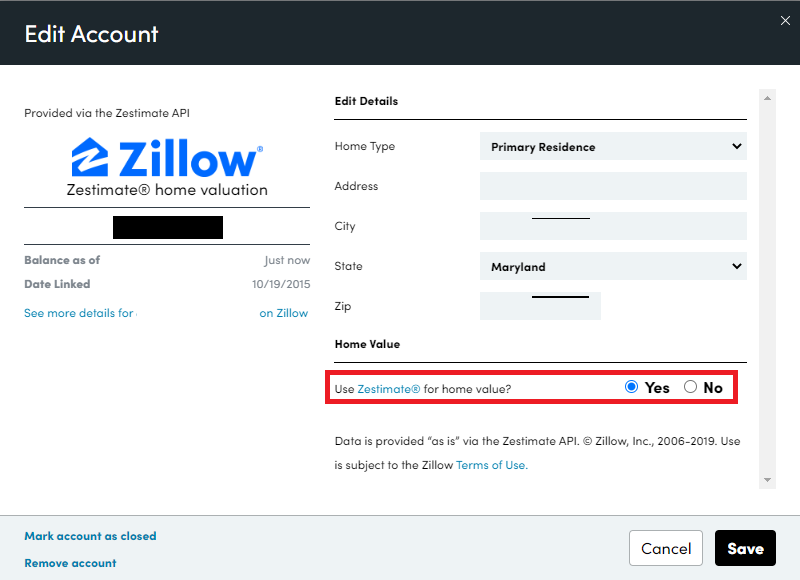
I’m not sure how I feel about Zillow’s Zestimates as an accurate measure (here are some other free home appraisal tools) but I set my home’s value at my purchase price because I need something to offset my negative mortgage balance.
For the longest time, the Zillow information for our house was wrong but I didn’t care enough to go through the process of updating it.
I don’t want my perspective on our net worth affected by our home’s “value.” I just assume it has held the value we assigned at purchase. They have a feature where you can tie in a Zillow estimate (Zestimate), but I don’t use it.
If you invest in real estate, for rental or otherwise, I can see the Zestimate is a little more valuable because you’ll be interested in marking it’s value to the market (even if it’s an estimate).
Tracking Cryptocurrency Holdings
Empower also offers the ability to track your cryptocurrency holdings. You can add your cryptocurrency holdings and they will track the pricing based on CryptoCompare.
It’s tracked under “Other Assets” and you manually enter your holdings but the value will be tracked automatically. For example, you select your exchange followed by the currency and the amount you have. I don’t have any so this is all dummy information:

If you have cryptocurrencies, this is a convenient way to integrate them into your dashboard. I don’t think many, if any, other services off this yet.
Complimentary Portfolio Review
When you connect $100,000 or more in investable assets, you can get a free portfolio and personal financial review – they value it at $799. It’s complimentary and they take a closer look at your financial situation and can help you figure out if you’re on track to reach your goals.
They can do everything from finding whether you’re overpaying in fees to building a college savings plan, all without any obligation. It’s a fantastic way to get a second look at your situation and see if there are any spots you’re missing.

As you use the tool, you’ll periodically get pitched a free session (I suspect this is only if you’ve linked $100,000 in assets):

Other Free Tools
The free tools section offers the following:
- Investment Checkup: Given what you’ve shared in your enrollment, they would recommend an allocation. I’ll expand on this below.
- Retirement Planner: This looks at whether or not your current pace of savings will be enough to support your retirement. It’s a really fun tool I’ll have to play with some more. (can you tell I’m a forecasting/stats nerd yet?))
- Retirement fee Analyzer: This takes a look at all the expense ratios in your various accounts and tell you if you’re paying too much. The vast majority of our holdings are in Vanguard funds so there’s not much to see here.
- Advisor: This is a page where you can schedule a call with a fee only financial advisor. The fee is an annual fee and based on assets under management.
- The Currency™: The name of their blog.
So more on the Investment Checkup tab, this will take your investment profile and recommend a target allocation. Here’s mine:

Here’s where rebalancing comes into play. If things are out of whack, it’s important to rebalance each year. This is a good reminder.
They also offer an Advisory Service:

The tiers of financial plans:
- Investment Service (up to $200K in investable assets) – Access to free online tools and dashboard plus Financial Advisory Team, Tax Efficient ETF Portfolio, Dynamic Tactical Weighting, 401k Advice, Cash Flow & Spending Insights, 24/7 call access including weekends and after-hours
- Wealth Management ($200K – $1M in investable assets) – Everything in Investment Service plus Two Dedicated Financial Advisors, Customizable Individual Stocks & ETFs, Full Financial & Retirement Plan, College Savings & 529 Planning, Tax Loss Harvesting & Tax Location, Financial Decisions Support (Insurance, Home Financing, Stock Options and Compensation)
- Private Client (over $1M in investable assets) – Everything in Wealth Management plus Priority Access to CFP®, Advisors, Investment Committee & Support, Investment Portfolio Mix of ETFs, Individual Stocks & Individual Bonds (in certain situations), Family Tiered Billing, Private Banking Services, Estate, Tax & Legacy Portfolio Construction; Donor Advised Funds, Private Equity & Hedge Fund Review; Deferred Compensation Strategy, Estate Attorney & CPA Collaboration.
Empower hired advisors from other firms with a significant pedigree. My “assigned” Advisor is someone who was formerly at Wells Fargo Advisors – Private Client Group. He served as a Board Member of a not-for-profit, graduated from a prestigious university, and his entire profile is available under Advice -> Advisors.
When you talk to an advisor, you’ll discuss all the things you’d expect from any other financial advisor. You’ll start by discussing your goals, risk tolerance, future funding goals (like a house or a baby), and then build a plan that takes that all into account so you are financially prepared for the future. The management fee is straightforward, you just pay a percentage fee on the assets under management which starts at 0.89%.
👉 Learn more about Empower Personal Dashboard
Empower’s Investment Methodology
If you have Empower manage your investments, their methodology is a mixture of U.S. stocks and bonds, international stocks and bonds, alternatives and then cash. It’s based on academic research and modern portfolio theory, developed in the 1950s by Nobel Prize-winning economist Harry Markowitz. I won’t get into the details but the idea is that you try to invest in low and negatively correlated assets so that you can maximize returns while reducing risk.

There’s this idea of an efficient frontier – where you can maximize returns for that level of risk. The more risk you take, the higher the potential returns. But you want to get an asset allocation that maximizes your return for YOUR level of risk. If you don’t, you’re leaving money on the table.
Retirement Planner
I want to dive into the Retirement Planner a little bit because it offers a benefit that few other personal finance tools do well – it’s a replacement for Quicken’s Lifetime Planner tool.
Many people use Quicken’s Lifetime Planner to help forecast retirement and beyond, so it’s nice to see some of those features replicated in Empower.

With the Retirement Planner, you set your income events – how much you’re saving today, plus how much you will receive in retirement from various sources like a pension, Social Security, spouse’s Social Security (if applicable), etc. Then you set your Spending Goals, which can be recurring like “retirement spending” or can be one time events, like paying for education. Finally, you can edit their assumptions – withdrawal tax rate, inflation rate, plus your life expectancy.
Then Empower Personal Dashboard will tell you whether you’re on track to save for this, including a detailed cash flow table that will explain how it should all play out. It’s a good way to look at the whole picture forecasted out.
Click on “How can I improve this?” and you’ll be given a series of suggestions including adjusting your asset allocation, investing more money, selling losers to offset winners, etc.
Financial Roadmap
Empower Personal Dashboard offers a tool for wealth management clients called The Financial Roadmap. It’s essentially a guide that identifies financial planning topics that they can work on with you that include everything from analyzing your insurance coverage to optimizing your pension to charitable giving. It’s a really exhaustive list of potential topics and you get to prioritize – ensuring you work on the things that matter to you. Empower will look at your data to help with the list but ultimately you decide what to focus on.
As you work on various tasks and complete them, the progress bar will advance you forward so you get a sense of where you are. There’s a complete Planning History that explains what was discussed and recommended, which can be valuable whenever you need to revisit it in the future. It helps to know what you were considering at the time of the decision, something that’s extremely hard to do many years later.
Empower Personal Cash
Empower Personal Cash is their cash management account where you can earn money on cash held with Empower. If you opt to have them manage your money, you may not always have all your cash in the market. With Empower Personal Cash, your cash balances earn 4.70% APY.
It’s FDIC insured up to $1.5 million (it’s through a number of partner banks who themselves have $250,000 of FDIC coverage) but it’s extremely unlikely you’ll ever need that level of coverage!
Additional Services
On top of the tools, the wealth management, and the financial advisor, they also offer assistance in managing three financial challenges you’re like to face – 401(k) fund allocation, insurance coverage, and college savings.
With the 401k Fund Allocation, you can send a list of the funds your 401k (or 403b or health savings accounts) offers and they will help you pick the options that fit best with your strategy.
With Insurance Coverage, they look at all of your policies and find where you might need more insurance or add policies you don’t already have. They don’t sell you insurance, they’ll just tell you what you may need.
Lastly, saving for college can be daunting but they offer support that demystifies all the different college savings options available.
👉 Learn more about Empower Personal Dashboard
Smart Withdrawal
Smart Withdrawal is only available if you are an advisory client, so it’s not free and I haven’t used it first hand.
From what I can tell from the marketing materials, the tool is meant as a calculator for when you are in retirement. It will look at your entire portfolio and tell you the optimal withdrawal order to take advantage of your portfolio’s tax situation. It will take your income sources, your retirement needs, and chart it all out for you. If you hit the age when you need to take Requirement Minimum Distributions (RMD), then the tool will take that into account as well.
Since this is only available to advisory clients, this is in addition to working with a financial advisor who you can talk through these issues with anyway.
Empower Fees
Empower Personal Dashboard is free. The website is free, the mobile app is free, and the tools are all included.
It follows the “freemium” model where the tools are completely free but you can pay if you want tailored investment advice. You only pay a fee if you use their advisors and wealth management services.
The annual fee is based on the assets they are managing:
| Assets Managed | Annual Fee |
|---|---|
| $1 Million or Less | 0.89% |
| First $3 Million | 0.79% |
| $3 – $5 Million | 0.69% |
| $5 – 10 Million | 0.59% |
| $10+ Million | 0.49% |
Empower vs. Mint: Is Empower better than Mint?
Empower Personal Dashboard gets compared with Mint.com a lot. We consider Mint the best alternative to Empower when it comes to a free budgeting app.
Mint is a very popular budgeting and money management tool that is owned by Intuit, the creators of Quicken and TurboTax (Quicken is now owned by a private equity firm). In its day, as far as personal finance management went, Mint was the gold standard for aggregation. It’s easy to use, incorporates all of your accounts, and can give you a big picture of your finances pretty quickly.
The budgeting tools are great for someone looking to track their expenses and get a better handle on where their money is going. I used it for years and watched it mature from a cool free tool that pulled your data to what it is today.
The big difference is that Mint is coming at the question of management from the income and expenses side. It’s primarily a budgeting tool with a robust suite of tools to help you get on top of your spending and servicing of debt. It’s less sophisticated in the investing department so its tools are limited in that regard.
Is Empower Personal Dashboard better than Mint? Empower Personal Dashboard is better than Mint if you are focused more on investing than budgeting. If you’re looking for a budgeting tool, Mint is better. (and if you’re looking to change your budget, You Need a Budget is even better but it has a $6.99 per month fee)
Mint was built to be a budgeting tool, so it’s investing tools aren’t even close. Empower Personal Dashboard was built as a tool to facilitate long term planning and investing, with budgeting tools added later. The big knock against Mint is that there’s very limited customer service… but it’s free (heavily ad-supported) so you can’t expect 24/7 phone support. That’s unreasonable.
If you’re at the point where you’re looking at your investments and need a portfolio management tool (AND a decent budgeting app), Empower Personal Dashboard would be a better fit. It’s also free so there’s no harm in giving it a try.
👉 Learn more about Empower Personal Dashboard
Is Empower Personal Dashboard Safe?
As you’d expect, security is extremely important and should be with any software that even has a peek into your money. Empower Personal Dashboard uses AES-256 bank-level encryption and has two-factor authentication.
Empower Personal Dashboard will require you to register each device you use and will periodically request you to re-register them in a bid to keep you as secure as possible.
Internal controls are another strong suit – no employee has access to your information and it’s your account information is encrypted and stored at Yodlee. Yodlee has powered a lot of other company’s data for this purpose (they were the ones that supported Mint’s data for a long time) and they have strong encryption as well.
We asked Dr. James Curtis, professor of IT and Cybersecurity at Webster University, for his thoughts on security and the cloud:

The cloud is generally no less or more secure than a standard organization’s own network system. All computers, storage platforms, or transmission systems have the same vulnerabilities, with people being the single largest vulnerability of all risk elements. Utilizing standard security procedures is a best practice for cloud providers like Amazon, and they are quite adept at ensuring they comply with these best practices and standards such as the NIST standards for cybersecurity.
I do believe there is one area of concern that is more of a perception issue than anything else – the fact that the owner of the data doesn’t have direct control over the data because they are relying on a service-oriented model by contracting with a cloud service provider. So, essentially the cloud provider is asking the data owner to ‘trust’ them to keep their data secure.
I think this is not an issue with a reputable cloud service provider, but it is a risk factor that organizations should consider when deciding to outsource their data to a cloud provider, especially if they deem their data so sensitive that they need more stringent controls over it than is standard.
As for trusting companies like Mint and Empower Personal Dashboard, he shares:
In some ways this is similar to the cloud security risk management issue. While I would argue reputable companies like Intuit that own Mint are just as reliable as the cloud service providers like Amazon, and that they comply with the same security standards and best practices, there is a different type of risk associated with these applications because they are software-based applications requiring the highest levels of security to protect the data. Many of the issues with cloud services are related to transmission and storage of the data, while financial applications such as Mint and Personal Capital are more susceptible to risks by hackers who target single users or organizations.
About 80% of security risks are associated with the software of a system vice the hardware, transmission media, etc. As long as the user follows standard security protocols such as password protection, firewall, and virus monitoring and management, and other related cybersecurity defenses, these financial applications are as safe as any other mainstream applications
No system is 100% safe but this one is pretty close. We take a much deeper dive into safety and data security at Empower Personal Dashboard and feel confident in their systems and processes.
What Needs Work?
In the first edition of this review, I had issues connecting with TradeKing because TradeKing had a different authentication system.
My original solution was to put all of my holdings in a portfolio and Empower Personal Dashboard tracked them separately. When Ally Bank acquired TradeKing, turning it into Ally Invest, it was now automatically tracked.
You can’t import historical data, so you only get about a month of history based on when you signed up. There’s no way to import data from Quicken or upload from historical downloads from financial institutions. Your history starts from when you sign up (about a month before that, based on how your financial institutions report transaction data). It’s a known limitation and there isn’t a plan to add historical data support in the future.
The budgeting tools need more work but it’s relatively new so I expect growing pains. It’ll improve but it still gives me the knowledge I need, monthly income and expense values, even if the categorization needs more hands-on help.
Final Word
Right now, Empower Personal Dashboard is my tool of choice when it comes to managing money and investments. At this stage in my life, investments are becoming a more significant part of our finances and so having visibility into that area is crucial.
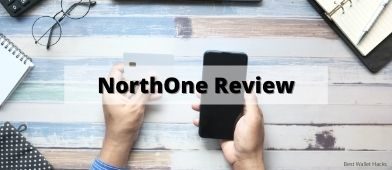


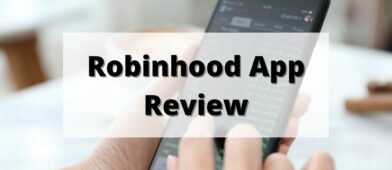
Brian @DebtDiscipline says
I recently started using personal capital. So far so good. I like you enjoy the benefit of having all my accounts rolled up into one place. Its a time saver.
That was the #1 benefit for me, the rollup since I couldn’t pull TradeKing data into Vanguard.
Tony says
I’m not too thrilled with Personal Capital. I’ve been using it for around a year. There’s a problem of some kind every couple months. Sometimes, there are issues connecting to accounts. Sometimes, accounts are listed multiple times. I’ve had an issue where it was taking the balance of one account at a source and listing it as the balance of other accounts at the same source. As of right now, it’s been more than 3 months since I’ve been able to connect to the brokerage (one of the largest in the US) where the majority of my assets reside. It’s also been 3 months since I’ve been able to connect to my mortgage account. Support just keeps saying they’re continuing to work on it.
Right now TradeKing isn’t tracking directly, I had to replicate my portfolio and thus it won’t update itself. It’s been like that for a couple months, though I’m not sure what the hold up is.
Mrs. Lewis (@LewisandWife) says
I’ve been using Personal Capital as well but struggle with the authentication process. My bank has a number off hoops to jump through to sign in using an outside system so it can be cumber some. Because they are a growing company, customer service isn’t instant but doesn’t take two weeks either. I want to keep using it in hopes of gaining better picture of my retirement plan.
I have yet to contact customer service so I don’t know, but so far my banks have authenticated without issue. I realize I may be lucky though.
Kyle says
Unfortunately the problem you have with your TradeKing accoount is an inevitable side effect of sites like this and Mint. Any time a bank or brokerage website updates its API, Personal Capital has to update their code to properly interact with it. It seems like it would be a huge ongoing maintenance project on their part. I can’t say I envy the developers over there, haha.
Luckily for me, I just love monitoring my accounts by hand. I really enjoy checking in on all my accounts to see how well I’m doing, and what needs improvement. It makes me feel like I’m more in control. I might give Personal Capital a try, though, to see if I like it better. It seems like their recommendations could be really helpful.
I hope they get your TradeKing to track automatically soon!
I did enjoy a more hands on approach, especially when I review my accounts every month, but I found the logging in process understandably cumbersome. Plus, rolling up the data is a better way of viewing my accounts anyway.
Back in the day, everyone just used Yodlee to do the data collection. They had links to banks, or scraped pages after logging in, and so you had just one point of failure/maintenance. I don’t know if PC took that in-house but I doubt it. Give it shot and let me know what you think.
Expat Warrior says
I’ve been using Personal Capital for a while now. For the most part, it work well and is very convenient, but, unfortunately, it doesn’t connect very well with smaller financial institutions like Robinhood.com or small mortgage providers.
I think the online capabilities of some of the smaller mortgage providers is probably lacking so there’s nothing to hook into. As for Robinhood, they don’t even have a web interface right? It’s 100% via the app?
I think all aggregators would have problems with those since there are no hooks?
Expat Warrior says
Yes, you are correct on both counts.
Robinhood is only available via their app.
Also, Personal Capital allows their users to manually enter the dollar amounts of the smaller financial institution accounts into PC. If it’s one or two, it shouldn’t be too bad.
I have it monitor my TradeKing account by holdings, rather than direct link. So there are workarounds and for me it’s just one account.
Steven Honaker II says
You are actually incorrect Robinhood has a web interface at Robinhood.com
Ha, somehow the dates on my comments disappeared but that was an old one – there is a web interface now.
fehmeen says
I haven’t used Personal Capital but I have heard lots of good things about it, and by the looks of it, I think it has to potential to manage your personal finances pretty well, even if you don’t use your account for anything other than simply tracking your net worth.
Give it a shot and let me know how it goes!
Sara says
How does this site differ from a site like draftapp? Trying to decide which one to use.
I haven’t used draftapp first-hand but as I understand it the tool compares your investments with other people in various peer groups with an eye towards lowering your expenses and establishing a solid asset allocation. Personal Capital is an aggregator of your finances, which includes accounts outside of your investments (like bank, credit cards, etc.). The primary focus is also investments but it has the other parts of your money system tied in. DRAFT is laser focused on investments, PC is broader and has a bit of the expense management portion built in too.
Rod says
Like Sara, I’m also trying to decide, have you had any experience with Mint and if so, how does this compare to PC ?
I used Mint and it was good for budgeting and tracking expenses, it was (and from what I can tell, still is) bad with investing and portfolios. It was never designed to be for investments though, so you can’t fault it for that. I think Mint’s budgeting features are better than Personal Capital but Personal Capital’s investment tools are far superior.
If you think about the two and their history, Mint started as a budgeting tool to compete with Quicken. Personal Capital started as an investment tool to compete with robo-advisors. So their respective strengths are still in their original purpose/visions, they’ve just added what the other does and right now they don’t do the “other thing” better than their competitor.
SJ says
This is a general call out to find out if anybody has used their financial advice service. I have a work 403b from a job I left and am looking to convert it to a traditional IRA (and then maybe concert to a Roth IRA if I can get my head wrapped around how that works). My options are to get a vanguard account (no current account now) put it in betterment where I have some money, or now that I signed up for this personal capital account, wonder if I should use them. Just curious if anyone has any thoughts/input or experience with their financial advise.
Also in terms of just aggregating my accounts, I find that for my Mass Mutual account (that’s the 403b I’m looking to move) it doesn’t split up the money between traditional and Roth (I have both) and I’m now in the TSP and same thing – lumps it all in as one sum and doesn’t differentiate between Roth and traditional so I have to go in to those accounts anyway. Is that something where I can change a setting to fix or is that just unfortunately how it works.
Thanks!
SJ
Dan says
I tried Personal Capital and loved it until I realized someone else might have access to all my financial info. It’s not clear how much is shared with these investors in the shadows. Am I the only one concerned about this?
This is something all of these companies have to deal with and they have more to gain from keeping your personal information private. Security is always a concern when you put all this information out there, that’s for sure, and it’s a completely valid one. I’m comfortable with it though.
Frank says
One thing I’ve discovered Personal Capital does is log into your account more than once. I logged into my bank this morning at 11:59 and the bank’s website said the last time I logged in was 11:36 this morning. That was a little disconcerting since it wasn’t me. I contacted the bank and they were able to figure out by IP address that it came from Yodlee which is what Personal Capital uses for authentication. I know it’s read only and they can’t do anything with it but I’m not sure why they do it more than once and perhaps on a semi-regular basis. I also realize they want to know what my accounts look like so they can decide how assertively to try to persuade me to sign up for their management service. Has anyone else experienced this? I’m going to call them and ask them not to look at my accounts again.
I’m not surprised but I wouldn’t have expected it, I’d love to hear what they say, can you keep us updated?
Sam says
They pull data every 24 hours or when you login Personal Capital. This keeps the data on PC recent, so it is fresh when you login.
FrugalPrice says
This looked exciting to me since Quicken helped me get control of my finances years ago. But one thing that concerned me was how they actually linked the accounts.
For some links, they want you to provide the actual username and password for accessing the account. I wasn’t very comfortable with that. But I did find that you could do manual investments where you just tell it your stock holdings and it will pull stock prices and update your net worth. It might mean extra work for me whenever I buy/sell something, but it gives me a little bit more peace of mind.
If you’re uncomfortable logging in (which is how all the tools do it), manual investments is the best alternative and they can update it based on that.
David Olsson says
I like the functionality of personal Capital. However, it has a lot of trouble authenticating my accounts. And though I have left several support tickets I have not gotten so much as an acknowledgement of my question much less a solution. Very unhappy with customer service.
Michelle says
I agree! I link all my accounts, start getting my history going, and then have to try for days to link accounts back. End up deleting and starting over with them…only to find that I can’t get them linked. I LOVE the site, but it might be more trouble than it’s worth (which i understand is free). Wonder if I had them manage my $$ if the site would work better 🙂
As it is, tonight I try again to link my Fidelity Netbenefits (again) and won’t link and then see my newly linked American Funds has to be relinked…..argh!
Think I’ll send another support e-mail.
Trisha | MendingPockets says
Hi! Thanks for this review! I’ve been trying to figure out how to get my TradeKing, now Ally to connect. You mentioned that it connects now through Ally Invest. I searched for that in Personal Capital and cannot find it. Could you tell me exactly which of the Ally options you used? Ally Bank didn’t work, that’s for cash accounts. Ally Financial Services appears to be for loan accounts…etc. Your article is the first I’ve read that mentioned that there IS a working solution for former TradeKing accounts, so I’m excited to see how to get it to work. Thanks!!
Hi Trisha! At the time I wrote it, I was wrong. It didn’t link in my Ally Invest. I saw this comment and went back in to check and it appears that Personal Capital automatically pulled it in. I have a new Ally Bank listing under the Investment category.
Casey says
I signed up for Personal Capital last March when comparing different financial software and platforms. In the late ’90s and early ’00s, I was a Microsoft Money user and loved all their features. It’s too bad Quicken hasn’t incorporated many of Money’s reporting and overview features.
I ultimately decided upon Quicken for Mac since tracking financial transactions was more important than investments. QMAC 2018 made some improvements for investments, however it’s very lack luster.
I recently opened an IRA account with TD Ameritrade. I am little disappointed with how it detects asset allocation and creating target allocations.
This week I accessed my PC account and linked my TD and TSP accounts. It really like how it aggregates my two retirement accounts to provide an overall view allocation and US sectors. I am going to stick with using PC to monitor my brokerage and retirement accounts.
It wasn’t until last week I received an email offering a free financial consultation. It makes me wonder if my significant increase of holdings in my brokerage account and adding the TD account didn’t trigger an alert for them to assign an advisor and generate an auto-email to me.
I suspect it likely does generate an automated trigger. You need to have a certain level of assets before a human analysis is valuable to them and valuable to you. If all you have is debt, the financial consultation will be short – “Please pay down your debt.”
I think it’s important to view a lot of different allocations, get different opinions, but PC’s a good voice to have in that chorus.
Ron Thomas says
I read this review as my wife and I start to look into an alternative to Quicken. What I noticed:
1) most of the screenshots show all sorts of fluff that we don’t need or would consider using – we just need a basic program to manage our accounts – especially our checking account;
2) storing our personal data on some server in the cloud? No thank you. The recent revelations of the hardware security issues designed into nearly all Intel processors shows that trusting the convenience of the “magic” cloud is foolhardy ..
1. Yes, if all you want is tracking then this might be overkill. Or it might be helpful, doesn’t hurt to try… 🙂
2. … Unless you are uneasy with data in the cloud. I need to do a full post on security and these types of services but it’s generally considered safe. But if you’re uneasy, there’s nothing anyone can say (nor should they be able to convince you, it’s your data after all so you have to protect yourself, I totally get that) to change your mind.
Henry A. Stewart says
Does Personal Capital have any provisions for handling option trading. I would not mind putting the information in manually if there is a way to track my option trading?
I’m afraid I don’t know, I don’t delve into options so I have no way of looking in my account to see.
Tom Walsh says
I use Personal Capital for account aggregation and retirement projections. Although the Retirement Planner indicates it applies a tax rate to the projection, I don’t know if they include it in the Annual Retirement Spending. Tax payments are not broken out on the Detailed Cash Flow table.
Any idea how taxes are addressed in the retirement projections?
In the Disclaimer, the last paragraph seems to indicate that all portfolio withdrawals are treated with a 20% tax unless you set it to something different.
Art Benjamin says
Does Personal Capital have the capability to print checks? I currently use Quicken Home & Business 2016 which is finally running OK after a lot of recent upgrading and user login glitches, but their upgrade – Quicken 2018 – has changed from a single priced program to an annual subscription program. I’m not sure it’s worth it. I track my investments manually, but occasionally need to print checks from two checking accounts.
I’m afraid Personal Capital does not print checks.
Ron says
I have been. Using Quicken for years for tracking all my accounts. I also use it to categorize my wife’s small business income/expenses so that I can print an end of year analysis for tax purposes. Is this possible in Personal Capitals software? I don’t like the fact that Quicken has gone to a subscription service, therefore looking for alternatives.
Hi Ron – Yes you can. You can tag income and expenses as Business, Medical, Reimbursable, or Tax Related. “Business Miscellaneous” is also a category for a transaction but that’s for obvious business expenses (and you can create your own categories). A restaurant bill, which is a restaurant bill first and a business transaction second, might warrant the tag.
Then in the transaction screen (Overview -> Transaction), you can search for “business” and it’ll just show you transactions tagged as business. You can export all transactions and that data will be passed through, so you can filter with Excel on just those tagged with business.
Lynn says
One feature I use from Quicken is the downloading the transactions, including the stock dividend, which I include in my rate of return calculation. Does that feature available in PC?
You can download every transaction in Personal Capital.
Walt Taylor says
Nothing “free” is ever truly free and I get that they’re running a business that’s trying to make money, but I had to move on from PC after getting deluged with popups, emails, and phone calls about scheduling a call with one of their advisors.
Not interested…so give me the option to say so and stop bugging me or, at minimum, at least leave me alone for 4-6 months before starting the hard press again… and even then give me the option to opt-out for another period of time. Very disappointing.
Did you ever pick up and say you’re not interested? I did and the phone calls stopped.
Walt Taylor says
Yes. It was quiet for about a week and then a new person resumed the calls/voicemails. It happens. Just became too much for me…
There’s undoubtedly value in this tool for many people and I completely recommend that folks give it a try. It’s just not the type UI/UX friction that I’m willing to accept – in my mind it diminishes the value of drawing me in and me wanting to reach out and expand the relationship.
Oh wow, that would be annoying. For me, the calls stopped once I talked to the rep and told them I wasn’t interested. I totally understand the annoyance though.
Harold Anderson says
Jim;
Thank you for the great review and maybe you can help me with a few questions. I used to use Quicken but stopped a because data entry too much time. I think you mentioned this as one of your concerns. I need to keep track of our cash flow first, but would like to grow into investment analysis. I want the ability to do it on a PC and on my portable devices. I also want to search past entries, even years in the past. It would be great to be able to scan a receipt and link it to the entry (but that is a wish list item). How long do Mint and Personal Finance let you go back in the search features. I wasn’t sure if they let you print cash flow statements? Any comments are appreciated. Thank you for your advice.
I’m not sure how long but my guess is they both will let you go as far as you have data.
John Smith says
One problem I’ve had with all Quicken replacements I’ve tried, Mint & Personal Capital is they are great for telling you what has already happened, they are geared to investments but they are useless for seeing what is coming. I’ll schedule payments as much as a month in advance normally. With Quicken (about the only thing) it works, I enter future transactions, etc. All the rest? They have no clue. With Quicken I’ve a good idea of what is happening for the coming month. Mint and PC can’t tell me what is happening the rest of the day. With Quicken continuing to crumble I’m thinking of dusting off Excel and simply going manual.
Excel won’t solve your prediction/future view issue though but that’s what I use too, PC to pull data, Excel to track because that’s how I’ve been doing it for 15+ years. Excel is the best way to go if you want the tailor everything (and if you want automation, Tiller can do that)
Alison says
This was exactly my concern too. Like John, I have Quicken programmed to automatically enter my bill payments 30 days ahead of time. I need to be able to plan 30 days out. I’m disappointed that there doesn’t seem to be anything comparable out there.
It’s a feature I have to have. I guess I’m stuck with Quicken for now – even though I hate it.
Pmiddy says
I love Personal Capital, but is there a way to have the value of my debt/principal for my mortgage show up rather than the balance due at my next payment?
For example, say my home is valued at $300k. If I add that to my portfolio, my net worth (according to PC) goes up 300k. But in reality, my net worth shouldn’t go up that amount because I also still owe 200K on my mortgage. When I tie my mortgage company’s (Home Point Financial) account to PC, it shows that my account balance is -$2,000. That’s my next payment due, not the amount of debt I actually have (or any equity I’ve achieved in the house).
How do I square this other than not adding my home?
Hmmm, I have a Wells Fargo mortgage and when I list it under mortgage it shows my balance, a massive negative number that offsets my home. It could be an issue with how Home Point Financial reports your balance?
pmiddy says
Thanks. I figured it was more of a Home Point issue. That’s unfortunate.
MyFreedomDollar says
Jim, thanks for sharing your Personal Capital review.
I have had a similar issue with my Ally Invest/Trade King account not displaying correctly. Do you recall doing anything specific to resolve the issue? My Ally Invest holdings do not display properly within the dashboard – the dollar amount is shown, but it is viewed as cash and will not recognize the individual holdings or asset allocation within the account.
I would LOVE to get this fixed! Thanks, Jim!
I’ve had the same issue, it shows the holdings as X shares of $1. I only use Personal Capital as a tool to pull information and my net worth sheet only tracks the account value. I don’t track individual holdings.
It does make my asset allocation analysis in Personal Capital all wrong though because it shows a huge slug of stock as cash. Fortunately, I don’t use that piece in planning. 🙂
David Foster says
I have also been very pleased with Personal Capital. I relied on Quicken for many years but when I switched from a Windows computer to an Apple I learned that the Apple version of Quicken was inadequate for my needs. I thus was very pleased to learn that Personal Capital was not only better for my purposes than Quicken and easier to use but completely FREE. That said, there are still a few quirks that I find annoying:
First, Personal Capital has no investment category for Rental Real Estate.
Second, and less significant, Personal Capital categorizes some of my mortgages as “loans” rather than mortgages collateralized by my Rental Real Estate.
Anthony M. says
I was lured into subscribing to Personal Capital by the promise of useful “free” financial tools. I was immediately subjected to multiple come-ons for fee-based financial services and my email was shortly thereafter subjected to a myriad of financial, insurance, and real estate solicitations. Thanks for nothing.
I told them I wasn’t interested when they called and they’ve stopped calling.
As for the email, I haven’t gotten anything since signing up. It could be another company you signed up for at around the same time.
ChuckSTL says
Jim, thanks for your detailed review of PC.
I have used Quicken since the DOS days, until recently. For reasons some have mentioned here (and others), it seemed to me Intuit had slowly become the “evil empire”.
I worried about security of an online aggregator tool, but your article on that topic helped ease those concerns.
After signing up, and linking accounts I liked some of the features and display options. Then, I started looking for how to get a historical perspective. As a new user, it looks like I only have the last quarter of data.
In Quicken, I could import a QIF, or OFX file to provide some history. This visibility is what helped drive investment decisions, indicating when changes were needed. Without it, as a new PC user, I feel like I’m “flying blind”. I can’t see investment trajectories. With PC, I’ll only get this perspective when data slowly accumulates. I’m pretty shocked PC has no ability to add previous yearly, semi-annual or quarterly data points to augment newly acquired investment data. This would provide much needed perspective for a long-term investor who is new to PC. (If you’ve been using PC for 15 years, you already have the data to obtain this historical perspective.)
I may stick with PC, but was hoping it was going to be the “go-to” solution. Now I’m thinking the search will continue. If you are just starting out, PC seems to provide a lot of function for minimal time investment. For someone switching from a previous tool with significant history, PC will feel like driving a car without rear view mirrors. 🙂 It’s a bit disconcerting.
I’m surprised there are not more comments regarding this, and that it was not mentioned in your review. (When I Googled for how to add historical data to PC, I found the limitation stated on the PC website.) In the spirit of full disclosure, you might want to point out this limitation for new converts who have used other investment tracking tools.
Regardless, you provided an informative review.
Thanks! 04/13/2019
Yeah that is one limitation, you can’t import data so you’re starting “fresh” which is fine if you’re twenty and have no data. It’s less appealing if you have years of data, unfortunately. I’ll add this to the “what needs work section.”
dlk says
I’ve used Personal Capital for several years now. They perform as advertised UNLESS anything changes with your interface access to your accounts. My bank changed their software which messed up the interface access. It has been two months now and their IT department still hasn’t fixed the interface with no relief in sight. What good is the account if you cannot update transactions and balances? Sure the service is worth what you paid for it. But it leaves me wondering if they would manage your money like this also. I’ll contact support again in six months. In the mean time I’m back to using Mint. They fixed their interface with my bank within two weeks. Just sayin…
Mike Boteler says
The main feature that I use in Quicken is scheduling transactions in my checking account, so I know if I need to transfer additional funds to cover expenses. I can’t figure out how to do that in Personal Capital or any other app. So I might have to stay with Quicken.
Do you schedule the transaction to happen sometime in the future from within Quicken?
Blake says
Moved away from Quickbooks and tried Mint. The issue with Mint was – for bank accounts, they don’t show your cash balance at each transaction. Just the current cash balance. And with that, what I want to do is enter upcoming inflows and outflows and see how those transactions impact my cash balance. Mint won’t allow me to enter future transactions (paycheck, mortgage, credit card payment, etc) and see how those transactions effect my cash balance. This is similar to a checkbook register. You see today’s cash balance, you add inflows and outflows and also see after each transaction if you dip negative in your bank account. Would PC show me this level of detail?
Personal Capital’s budgeting and cashflow tools are fairly rudimentary, you aren’t able to add transactions. Every transaction comes from another source (i.e. credit card), so you can’t add anything.
Mahesh says
Personal Capital is a little bit of help but I am not able to overcome two big problems.
1 – I have 12% allocated to a S&P Index trust in company’s 401k which unfortunately goes into PC’s Unclassified bucket. I tried to classify manually but PC ignores it. Which means the allocations, projections, investment checkup and a lot of useful features are utterly useless to me.
2 – When I make transaction within the account (i.e. exchange a fund with another mutual fund within the account), somehow the account balances show as if there was a withdrawl. So the trending and comparison charts become useless.
Also there used to be a feature where I could click on an account and see the holdings. That got removed sometime ago so the only way to check holding is using checkboxes in account filter which is cumbersome. For a given holding it is hard to find asset location.
Scott says
The portfolio tools are great but I also use Quicken for bill payment and entering an occasional check. It lets me know when I have a bill due in the calendar. How do you deal with your due bills, be it credit card, cable, utilities, etc, etc
I don’t use any tools for bill payment. It’s either automatic and linked to my banking (such as for utilities, as an example) or I pay them manually (I don’t have too many bills).
LW says
I’ve had Personal Capital for some time now so I’ve built up a bit of historical data on the platform. While it’s useful to be able to see my investment accounts and balance history in one place, I find it challenging to figure out where my portfolio’s gains and losses are over the last weeks/months. PC seems to only display historical profit & loss at an account level (or for 1 day at the security level).
Is this an issue for anyone else? Have you found other tools that can actually analyze some of your historical investment performance?
Personal Capital isn’t designed to give you a deep dive into your portfolio, it’s more of an aggregator and while it’s analysis tools are useful, it’s not going to be as powerful as you’re needing.
For those, I suggest you check our list of the best portfolio analyzers (it includes PC but also several others that will give you a much deeper dive).
Khoa says
I like PC a lot. One thing I wish PC had is portfolio exposure at the company level instead of at the securities level. Let’s say my portfolio consists of $5,000 worth of Netflix stock, $3,000 worth of Netflix call options, and $2,000 worth of Tesla stock. Currently PC says my portfolio ex 50% exposed to Netflix. In reality, it’s 70%. With call options in only one or two stocks, it’s no big deal to manually adjust. When you trade options on more than a handful of stocks, the manual adjustment becomes tedious.
Ohhh that’s good to know. I don’t mess with options so I never considered how to factor in call options.
Buzz Wiliams says
Thanks for the well done review on personal capitol. Will I be able to do my bank account with it starting January 1, 2021.? It look to be the best replacement for Quicken.